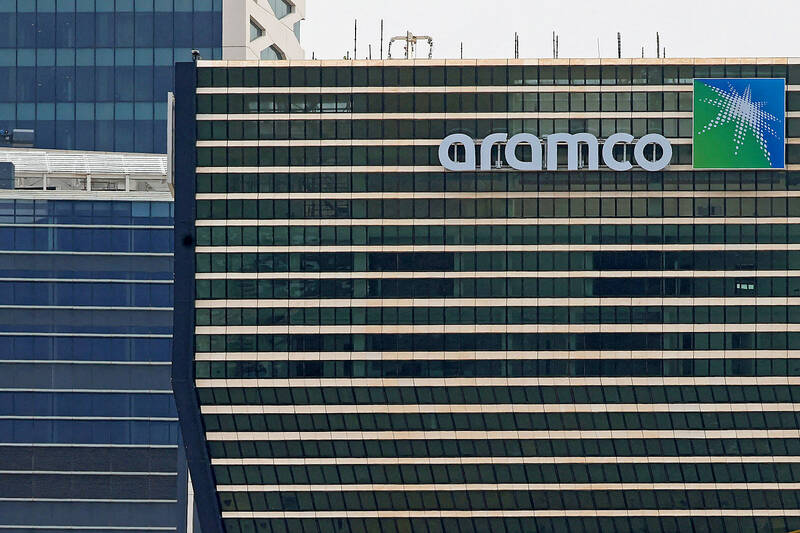Saudi Arabian Oil Co (Aramco), the Saudi state-owned oil giant, yesterday posted first-quarter profits of US$26 billion, down 4.6 percent from the prior year as falling global oil prices undermine the kingdom’s multitrillion-dollar development plans.
Aramco had revenues of US$108.1 billion over the quarter, the company reported in a filing on Riyadh’s Tadawul stock exchange.
The company saw US$107.2 billion in revenues and profits of US$27.2 billion for the same period last year.

Photo: AFP
Saudi Arabia has promised to invest US$600 billion in the US over the course of US President Donald Trump’s second term.
Trump, who is set to touch down in Riyadh tomorrow on his first official foreign trip since he retook the Oval Office, in January said that he wants that number to be even higher, at about US$1 trillion.
Meanwhile, the Saudi Arabian de facto ruler, Crown Prince Mohammad bin Salman, has his sights set on a US$500 billion project to build Neom, a vast, futuristic city in the desert along the Red Sea.
The kingdom would also need new stadiums and infrastructure costing tens of billions of dollars by 2034, when Saudi Arabia is to host the FIFA World Cup.
The announcement of Aramco’s first-quarter results comes as the OPEC+ alliance has ramped up oil production. The oil cartel has agreed to boost output by 411,000 barrels per day next month, as uncertainty driven by US tariffs has rippled through Middle Eastern markets. That means Saudi Arabia would likely need to borrow or spend reserve funds to finance the crown prince’s expensive goals.
“Global trade dynamics affected energy markets in the first quarter of 2025, with economic uncertainty impacting oil prices,” Aramco president and CEO Amin H. Nasser said in a statement.
Benchmark Brent crude traded on Friday at more than US$63 a barrel, down from highs of more than US$80 last year.
Aramco has a market value of more than US$1.6 trillion, making it the sixth-richest company behind Microsoft Corp, Apple Inc, Nvidia Corp, Amazon.com Inc and Alphabet Inc. Analysts see the company as a trend leader for global oil markets.
Aramco traded at over US$6 a share yesterday, down from a high of around US$8 last year. It has dropped over the past year as oil prices have dipped, and in recent months.
A fraction of Aramco trades on the Saudi Stock Exchange, or Tadawul, while the lion’s share of the company is owned by Saudi Arabia’s government, helping pay for expenditures and adding to the wealth of the country’s Al Saud royal family.

CHIP RACE: Three years of overbroad export controls drove foreign competitors to pursue their own AI chips, and ‘cost US taxpayers billions of dollars,’ Nvidia said China has figured out the US strategy for allowing it to buy Nvidia Corp’s H200s and is rejecting the artificial intelligence (AI) chip in favor of domestically developed semiconductors, White House AI adviser David Sacks said, citing news reports. US President Donald Trump on Monday said that he would allow shipments of Nvidia’s H200 chips to China, part of an administration effort backed by Sacks to challenge Chinese tech champions such as Huawei Technologies Co (華為) by bringing US competition to their home market. On Friday, Sacks signaled that he was uncertain about whether that approach would work. “They’re rejecting our chips,” Sacks

Taiwan’s long-term economic competitiveness will hinge not only on national champions like Taiwan Semiconductor Manufacturing Co. (TSMC, 台積電) but also on the widespread adoption of artificial intelligence (AI) and other emerging technologies, a US-based scholar has said. At a lecture in Taipei on Tuesday, Jeffrey Ding, assistant professor of political science at the George Washington University and author of "Technology and the Rise of Great Powers," argued that historical experience shows that general-purpose technologies (GPTs) — such as electricity, computers and now AI — shape long-term economic advantages through their diffusion across the broader economy. "What really matters is not who pioneers

TAIWAN VALUE CHAIN: Foxtron is to fully own Luxgen following the transaction and it plans to launch a new electric model, the Foxtron Bria, in Taiwan next year Yulon Motor Co (裕隆汽車) yesterday said that its board of directors approved the disposal of its electric vehicle (EV) unit, Luxgen Motor Co (納智捷汽車), to Foxtron Vehicle Technologies Co (鴻華先進) for NT$787.6 million (US$24.98 million). Foxtron, a half-half joint venture between Yulon affiliate Hua-Chuang Automobile Information Technical Center Co (華創車電) and Hon Hai Precision Industry Co (鴻海精密), expects to wrap up the deal in the first quarter of next year. Foxtron would fully own Luxgen following the transaction, including five car distributing companies, outlets and all employees. The deal is subject to the approval of the Fair Trade Commission, Foxtron said. “Foxtron will be

BUBBLE? Only a handful of companies are seeing rapid revenue growth and higher valuations, and it is not enough to call the AI trend a transformation, an analyst said Artificial intelligence (AI) is entering a more challenging phase next year as companies move beyond experimentation and begin demanding clear financial returns from a technology that has delivered big gains to only a small group of early adopters, PricewaterhouseCoopers (PwC) Taiwan said yesterday. Most organizations have been able to justify AI investments through cost recovery or modest efficiency gains, but few have achieved meaningful revenue growth or long-term competitive advantage, the consultancy said in its 2026 AI Business Predictions report. This growing performance gap is forcing executives to reconsider how AI is deployed across their organizations, it said. “Many companies